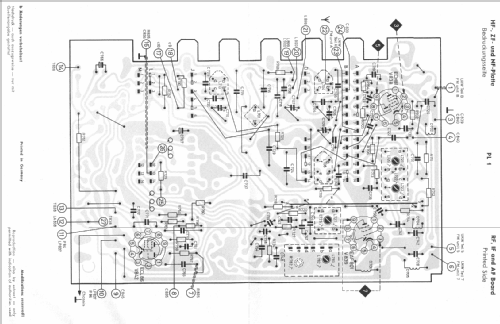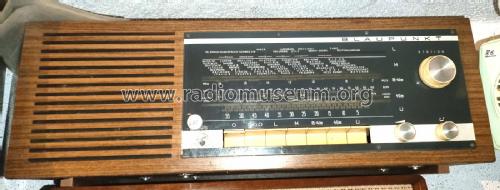Oslo 7.626.200
Blaupunkt (Ideal), Berlin, später Hildesheim
- Hersteller / Marke
- Blaupunkt (Ideal), Berlin, später Hildesheim
- Jahr
- 1966–1968
- Kategorie
- Rundfunkempfänger (Radio - oder Tuner nach WW2)
- Radiomuseum.org ID
- 26459
-
- anderer Name: Ideal-Radiotelephon- und App-fabr. || Ideal-Werke AG; Berlin (ab 1934)
- Marke: Rotstern
Klicken Sie auf den Schaltplanausschnitt, um diesen kostenlos als Dokument anzufordern.
- Anzahl Röhren
- 4
- Hauptprinzip
- Superhet allgemein; ZF/IF 460/10700 kHz
- Anzahl Kreise
- 6 Kreis(e) AM 10 Kreis(e) FM
- Wellenbereiche
- Langwelle, Mittelwelle, zwei mal Kurzwelle und UKW (FM).
- Betriebsart / Volt
- Wechselstromspeisung / 110; 127; 220; 240 Volt
- Lautsprecher
- Dynamischer LS, keine Erregerspule (permanentdynamisch) / Ø 13 cm = 5.1 inch
- Belastbarkeit / Leistung
- 3 W (Qualität unbekannt)
- Material
- Gerät mit Holzgehäuse
- von Radiomuseum.org
- Modell: Oslo 7.626.200 - Blaupunkt Ideal, Berlin,
- Form
- Tischgerät, Tasten oder Druckknöpfe.
- Abmessungen (BHT)
- 520 x 185 x 185 mm / 20.5 x 7.3 x 7.3 inch
- Bemerkung
- Dioden: 2× AA113
- Nettogewicht
- 6.4 kg / 14 lb 1.6 oz (14.097 lb)
- Datenherkunft extern
- erb
- Datenherkunft
- Handbuch VDRG 1966/1967
- Weitere Modelle
-
Hier finden Sie 3593 Modelle, davon 3282 mit Bildern und 2332 mit Schaltbildern.
Alle gelisteten Radios usw. von Blaupunkt (Ideal), Berlin, später Hildesheim
Sammlungen
Das Modell Oslo befindet sich in den Sammlungen folgender Mitglieder.
Forumsbeiträge zum Modell: Blaupunkt Ideal,: Oslo 7.626.200
Threads: 1 | Posts: 1
Reparaturbericht:
- Keine Anodenspannung. Gleichrichter durchgebrannt, wird durch 4 x 1N4007 ersetzt, da gerade vorhanden.
- eine Strommessung hinter dem Gleichrichter zeigte zunächst 60 mA auf UKW. Nach 10 Minuten stieg der Strom auf über 100 mA an.Dadurch wurde wohl der Gleichrichter (B250 E100) zerstört.
- nach Entfernen der Endröhre ECL86 blieb der Strom konstant bei 38 mA. Ursache also bei der Endröhre. Koppelkondensator und Gitterableitwiderstand am Pentodensystem in Ordnung.
- ECL86 wieder eingesetzt. Spannung an der Kathode der ECL86 stieg langsam von 6,8 V auf 9 V
Offensichtlich ein Fall von Gitteremission der hierfür anfälligen ECL86. Nach Tausch der Röhre war der Fehler beseitigt.
Gruss, O.R.
Ottmar Rollmann, 22.Mar.12




























